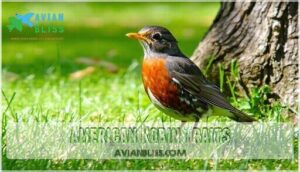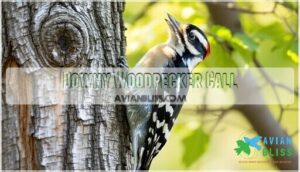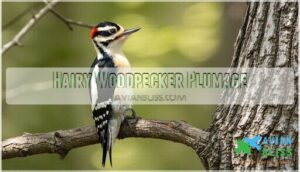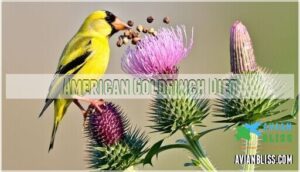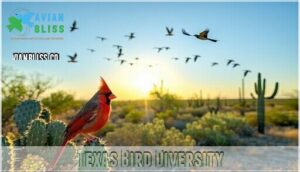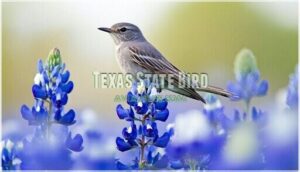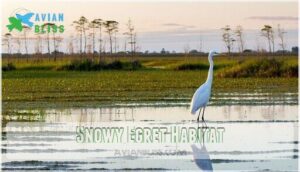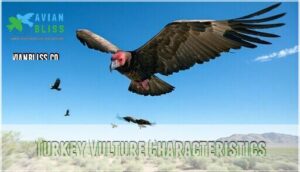This site is supported by our readers. We may earn a commission, at no cost to you, if you purchase through links.

The Northern Cardinal’s bright red flash catches your eye first, while the Northern Mockingbird serenades you with borrowed songs from other species. Mourning Doves coo softly from power lines, and Great-tailed Grackles strut across parking lots like they own the place.
American Robins hop along lawns hunting worms, and Downy Woodpeckers tap rhythmically on oak trees.
Texas hosts over 600 bird species, making it America’s birdwatching hotspot. Understanding which birds call your specific region home can transform ordinary moments into fascinating wildlife encounters with common birds and help you appreciate the beauty of Texas.
Table Of Contents
- Key Takeaways
- Texas Bird Species
- Common Backyard Birds
- Texas Bird Diversity
- Texas State Bird
- Waterbirds and Raptors
- Frequently Asked Questions (FAQs)
- What are the most common backyard birds in Texas?
- How many bird species are in Texas?
- What birds live in East Texas?
- Are there wild birds in Texas?
- What birds live in Texas in winter?
- What birds have yellow bellies in Texas?
- What is the common bird in Texas?
- How do I identify a bird in my backyard?
- What is Texas’ main bird?
- What are those tiny brown birds called?
- Conclusion
Key Takeaways
- You’ll easily spot Texas’s most common backyard birds – Northern Cardinals with their bright red plumage, Northern Mockingbirds mimicking other species’ songs, Mourning Doves cooing from power lines, and Great-tailed Grackles strutting confidently across parking lots.
- Texas ranks as America’s second-best birdwatching destination with 664 documented species across diverse habitats, from East Texas pine forests hosting endangered Red-cockaded Woodpeckers to the Rio Grande Valley’s tropical species like Green Jays.
- You can identify birds by focusing on key features – observe size, distinctive colors, beak shape, behavior patterns, and calls to distinguish between species like the American Robin’s rusty breast or the Downy Woodpecker’s high-pitched whinnying call.
- Different Texas regions offer unique bird specialties – West Texas deserts feature Colima Warblers in mountain canyons, Central Texas Hill Country hosts the endangered Golden-cheeked Warbler, and coastal areas attract magnificent waterbirds like Great Egrets and Snowy Egrets.
Texas Bird Species
You’ll find five bird species that dominate Texas skies, from the vibrant red Northern Cardinal to the vocal Northern Mockingbird.
These common residents showcase the remarkable diversity that makes Texas home to 664 bird species, each adapted to the state’s varied landscapes from coastal marshes to desert scrublands, highlighting the state’s unique position as a habitat for a wide range of species, including those that thrive in varied landscapes.
Northern Cardinal Description
You’ll instantly recognize this vibrant Texas resident by its striking Cardinal Plumage and distinctive features.
The Northern Cardinal displays brilliant red coloring with a black facial mask and short pink bill, making bird identification straightforward across their Cardinal Range.
Key Cardinal features that capture hearts:
- Males showcase stunning crimson Cardinal Plumage year-round
- Females display warm brown tones with reddish tinges
- Both sexes sport that iconic pointed crest
These common species thrive in diverse Cardinal Habitat including woodlands, gardens, and backyards throughout Texas birds territory, maintaining their presence year-round.
Northern Mockingbird Characteristics
You’ll recognize Northern Mockingbirds by their gray upper parts and white underparts with distinctive black and white wing bars.
These Texas bird species showcase remarkable mimicry abilities, copying songs from dozens of other birds and even mechanical sounds.
Their vocalizations include original melodies plus borrowed tunes, creating complex concerts that demonstrate advanced bird behavior.
Males display intense territorial behavior during breeding season, defending nesting areas aggressively while females focus on nesting habits in shrubs and trees.
Mourning Dove Habitat
Mourning Doves thrive in Texas’s diverse landscapes, making them one of the state’s most adaptable common species.
You’ll spot these graceful birds across various Texas habitats and birdwatching locations throughout the year.
Key Habitat Preferences:
- Urban Dove Habitats – Parks, gardens, and residential areas with trees
- Rural Dove Habitats – Open farmland, prairie edges, and grasslands
- Dove Nesting Sites – Low shrubs, tree branches, and platform feeders
These resourceful birds exploit abundant Dove Food Sources like seeds and grains while facing minimal Dove Habitat Threats in most Texas regions.
Great-tailed Grackle Range
Spanning across North America, South America, and Central America, you’ll find Great-tailed Grackles thriving in diverse environments from urban settings to wetlands.
Their remarkable habitat adaptation has fueled ongoing grackle expansion throughout Texas, where these common species demonstrate impressive regional variations.
The related common grackle, however, faces significant population decline due to habitat loss.
Range factors like food availability and climate influence their future distribution, making them essential subjects for Texas birdwatching enthusiasts studying bird ranges and Texas bird species patterns.
White-winged Dove Size
White-winged Doves measure 11 inches in average length, making them medium-sized among Texas bird species.
These common Texas birds display consistent wing span measurements across regional variations, though habitat impact can influence overall body condition.
When comparing bird sizes, Whitewinged Doves fall between smaller songbirds and larger raptors. Their compact build suits their diverse habitats from desert scrublands to urban environments throughout their range, making them well-adapted to various habitats.
Common Backyard Birds
You’ll find these common backyard species throughout Texas year-round, each with distinct traits that make identification straightforward.
Texas backyards offer year-round birdwatching gold with easily identifiable species waiting outside your window.
From the American Robin’s rusty red breast to the Downy Woodpecker’s high-pitched call, these birds offer excellent opportunities for beginning birdwatchers to practice their skills, with distinct traits that make them easy to identify.
American Robin Traits
You’ll spot the American Robin easily with its rusty red breast and dark head featuring white throat markings.
Robin Behavior includes ground-hopping while hunting earthworms and insects.
Their Robin Habitat like lawns, parks, and wooded areas are preferred by these Texas birds.
Robin Nesting occurs in trees using mud-lined cups.
Their Robin Song delivers cheerful warbles at dawn.
Robin Diet consists mainly of invertebrates and berries, making them beneficial for gardens.
Downy Woodpecker Call
You’ll recognize the Downy Woodpecker’s distinctive high-pitched whinnying call echoing through Texas backyards year-round.
This bird vocalizations pattern sounds like a horse’s soft neigh, making it one of the most recognizable Texas birds sounds.
The call frequency increases during breeding season when males establish territory.
Bird sounds are essential for survival, helping with communication and warning of danger.
Unlike similar calls from larger woodpeckers, the Downy’s call purpose includes both communication and foraging alerts, helping you distinguish this species from other bird songs in your area.
Hairy Woodpecker Plumage
You’ll instantly recognize a Hairy Woodpecker by its striking black and white striped head pattern and bold body contrasts.
Males sport a distinctive red patch on the back of their heads, while females lack this colorful marking entirely.
Key Hairy Woodpecker Plumage Features:
- Male Markings – Bright red rectangular patch on back of head distinguishes males from females
- Feather Patterns – Clean black and white stripes create zebra-like head design with minimal variation
- Plumage Variations – Texas birds show consistent coloring with occasional slight regional differences in intensity
- Juvenile Plumage – Young birds display duller colors with brownish tinges before developing adult patterns
- Regional Differences – Southwestern populations may appear slightly paler than eastern Texas Hairy Woodpeckers
American Goldfinch Diet
Unlike other woodpeckers that favor insects, American Goldfinch bird species maintain strict vegetarian bird diets year-round.
These birds show remarkable Thistle Dependence, with nyjer seeds comprising their primary food source. Their Seed Preferences include sunflower kernels and dandelion seeds.
Winter Diet shifts to dried seed heads from weeds and grasses. Understanding their Foraging Habits helps with effective bird feeding strategies.
Many bird enthusiasts use specialized seed feeders to attract these finches.
| Food Type | Season | Feeding Location |
|---|---|---|
| Nyjer seeds | Year-round | Bird feeders |
| Sunflower kernels | Spring/Summer | Feeders & plants |
| Weed seeds | Fall/Winter | Ground foraging |
House Sparrow Behavior
House Sparrows display fascinating social hierarchy and nesting habits that make them masters of urban adaptation.
These gregarious birds establish complex feeding strategies, often dominating feeders through aggressive posturing.
Their invasive impact stems from competitive behavior patterns that displace native species.
Bird behavior research shows House Sparrows form year-round flocks, with males defending territories through chirping displays.
Bird behavior observations reveal their remarkable ability to exploit human environments, making them one of the most successful urban colonizers worldwide, with a notable capacity for urban adaptation.
Texas Bird Diversity
You’ll discover incredible bird diversity across Texas, with 664 species calling the state home – the second-highest count in the U.S.
Each region offers unique species, from tropical birds in the Rio Grande Valley to forest specialists in East Texas piney woods.
Regional Bird Specialties
Texas offers distinct regional bird specialties that reflect the state’s diverse ecosystems.
East Texas birds like the endangered Red-cockaded Woodpecker inhabit mature pine forests, while Rio Grande Valley hosts tropical species including Green Jay.
West Texas birds such as Colima Warbler nest exclusively in Chisos Mountains’ high-elevation canyons.
Central Texas birds feature the Golden-cheekeked Warbler in Hill Country juniper woodlands, making Texas birdwatching locations uniquely specialized.
Texas is a prime location for birders, with many flocking to the state to experience diverse birding locations, and it offers a great opportunity for birdwatching.
South Texas Bird Species
You’ll discover Rio Grande Birds that exist nowhere else in the United States when exploring South Texas’s Valley Endemics.
These Subtropical Habitats support Green Jays, Altamira Orioles, and Plain Chachalacas—species that showcase Texas Tropics diversity.
Bird Conservation efforts protect over 300 documented types of birds in this region, making Texas ornithology particularly rich for observing local birds and unique bird species.
South Texas is known for its unique avian diversity, attracting birdwatchers from across the country.
Central Texas Bird Species
You’ll find several species thriving in Central Texas’s diverse landscapes, from hill country woodlands to urban parks.
These Texas bird species showcase remarkable Habitat Preferences and Seasonal Variations in their Urban Birdlife patterns.
- Lesser Goldfinch – bright yellow males frequent backyard feeders, especially during winter months
- House Finch – adaptable songbirds that excel in residential areas and established Birdwatching Spots
- American Robin – rusty-breasted visitors appearing more commonly during cooler seasons across Central Texas Bird Species range
Many residents support these birds through local bird product purchases.
West Texas Bird Species
West Texas showcases remarkable bird diversity across its desert habitats and grasslands.
You’ll spot Western Grebe and Swainson’s Hawk as signature species, alongside Lucifer Hummingbird and Colima Warbler in the Chisos Mountains.
These Texas bird species depend on conservation efforts protecting their specialized habitats.
If you’re interested in West Texas avian products, there are many options available.
Migration patterns bring grassland specialists like Baird’s Sparrow to overwinter in this critical region for Texas wildlife.
East Texas Forest Birds
Moving inland from West Texas’s arid landscapes, East Texas’s dense forests harbor remarkable bird species.
You’ll find endangered Red-cockaded Woodpeckers nesting in mature pines alongside impressive Pileated Woodpeckers.
These forest habitats support specialized species like Brown-headed Nuthatches and Bachman’s Sparrows.
Bird conservation efforts focus on maintaining longleaf pine ecosystems through prescribed burning.
Oak-hickory forests support diverse birdlife.
This Texas bird diversity showcases how forest habitat creates unique opportunities for birdwatching in Texas and species identification.
Texas State Bird
You’ll recognize the Northern Mockingbird as Texas’s official state bird since 1927, thanks to its remarkable ability to mimic dozens of other bird songs and even mechanical sounds.
This gray and white songbird with distinctive wing bars stands out not just for its vocal talents, but also as one of the most common year-round residents you’ll spot in gardens, parks, and open woodlands across the Lone Star State, known for being a common year-round resident.
Northern Mockingbird Facts
You’ll easily recognize the Northern Mockingbird by its incredible mimicry abilities, copying over 200 different bird songs and sounds.
This gray-and-white Texas bird species displays fierce territorial behavior, defending its space year-round.
Their vocalizations include original songs mixed with borrowed calls from other birds.
These skilled performers prefer open areas with scattered trees for nesting habits, building cup-shaped nests 3-10 feet high.
Their diet preferences include insects, berries, and fruits, making them excellent pest controllers for your yard.
Mourning Dove Migration
Mourning Dove migration patterns showcase remarkable adaptability across Texas bird migration seasons.
These migratory birds utilize major Dove Flyways, with Migration Triggers including temperature drops and daylight changes.
Climate Effects influence their timing, while Breeding Impact determines routes.
Texas bird species like Mourning Doves maintain stable Conservation Status despite environmental pressures affecting bird migration throughout North America’s corridors.
Bird Migration Patterns
Understanding bird migration patterns in Texas reveals fascinating seasonal rhythms that connect Arctic breeding grounds to tropical wintering areas.
Texas sits at the crossroads of major migration routes, with over 2 billion birds passing through each spring.
Migration Triggers include daylight changes and weather patterns, while Stopover Habitats provide essential refueling stations.
Climate Impacts and Migration Challenges increasingly threaten these ancient pathways, making Conservation Efforts essential for protecting these remarkable journeys.
Notable Texas Bird Species
You’ll encounter remarkable Texas bird species diversity throughout the state’s varied landscapes.
The Great Egret stands tall in both saltwater and freshwater egret habitats year-round, while endangered Texas birds like the Golden-cheeked Warbler require focused warbler conservation efforts.
Turkey Vultures showcase impressive raptor adaptations, soaring effortlessly on thermal currents.
Duck migration brings Northern Pintails to Texas wetlands each winter, adding to the state’s impressive bird species diversity for any Texas birdwatching guide.
Texas skies are also dominated by hawks, eagles, and falcons.
Golden-cheeked Warbler Habitat
You’ll find the Golden-cheeked Warbler exclusively in Texas Hill Country, where these endangered species depend on mature ashe juniper and oak woodlands for survival.
Habitat loss threatens their nesting ecology, making bird species protection essential.
These specialized Texas bird species require specific bird habitats – dense canopy cover and particular tree combinations.
Warbler conservation efforts focus on preserving these unique Texas bird habitats, as goldencheeked warblers can’t adapt to other environments like many bird habitats in Texas support, which is crucial for their survival.
Waterbirds and Raptors
You’ll spot magnificent waterbirds like Great Egrets and Snowy Egrets wading through Texas wetlands, while powerful raptors such as Turkey Vultures and Black Vultures soar overhead.
These impressive birds offer some of the most rewarding birdwatching experiences across the state’s diverse aquatic habitats and open skies, providing opportunities to see magnificent waterbirds in their natural environment.
Great Egret Description
Standing tall at 39 inches, you’ll spot Great Egrets by their striking all-white plumage and bright yellow-orange bill.
These magnificent Texas bird species showcase remarkable Egret Size compared to other waterbirds.
Their sleek necks extend gracefully while hunting fish, frogs, and small mammals.
Great Egrets thrive in both saltwater and freshwater environments across Texas, demonstrating impressive Habitat Variation.
Their year-round presence makes them essential for Texas bird species identification and adds to Texas bird species diversity, with their presence being a key factor in Texas bird species identification.
Snowy Egret Habitat
Snowy Egrets thrive in diverse Texas bird habitats and ecosystems, making them adaptable aquatic birds.
You’ll spot this elegant Texas bird in various locations:
- Coastal Wetlands – saltwater marshes and tidal flats
- Freshwater Marshes – inland ponds and lakes
- Feeding Grounds – shallow waters with abundant fish
- Texas Distribution – year-round residents statewide
Their Conservation Status remains stable thanks to protected wetland habitats throughout Texas.
Turkey Vulture Characteristics
You’ll recognize Turkey Vultures by their impressive six-foot wingspan and distinctive soaring patterns.
These raptors hold their wings in a characteristic V-shape while riding thermals across Texas skies.
Their bare red heads help them stay clean while feeding on carrion, making them nature’s cleanup crew.
| Feature | Description | Field Mark |
|---|---|---|
| Head | Bare red skin | Adults only |
| Wings | Dark with silver flight feathers | V-shaped soaring |
| Size | 26 inches long | 6-foot wingspan |
Black Vulture Range
Black Vultures have expanded their range substantially across Texas in recent decades, demonstrating remarkable habitat adaptation.
You’ll spot these bulky raptors throughout eastern and central Texas, with growing population density in urban areas.
Vulture expansion continues westward as climate impact creates favorable conditions.
Unlike Turkey Vultures, Black Vultures handle vulture competition aggressively, often dominating feeding sites, which is a key aspect of their Texas bird species behavior.
Their behavior includes year-round residency, making birdwatching easier for bird species identification enthusiasts.
Mallard Duck Population
Unlike raptors that soar overhead, mallards represent Texas’s most abundant waterfowl despite concerning trends.
You’ll find these adaptable ducks in wetlands across the state, where they depend heavily on habitat quality for survival.
Current mallard population challenges include:
- 6.6 million birds in 2024 – an 8% increase but still 16% below long-term averages
- 20% decline since 1998 despite overall waterfowl growth
- Texas hosts 90% of Central Flyway ducks during winter months
Mallard distribution patterns reveal their wetland dependence, with duck conservation efforts focusing on preserving critical Texas habitats.
Migration patterns bring these avian population members from Canadian prairies, making Texas bird species diversity essential for continental populations.
Population threats include habitat loss and changing migration behaviors affecting Texas bird species.
Frequently Asked Questions (FAQs)
What are the most common backyard birds in Texas?
You’ll spot Northern Cardinals, Mourning Doves, and Northern Mockingbirds most frequently.
Cardinals bring bright red flashes, while mockingbirds showcase their impressive vocal repertoires.
Great-tailed Grackles and White-winged Doves also visit regularly, and these birds, including the Northern Mockingbirds and Cardinals, are a common sight.
How many bird species are in Texas?
Texas hosts an impressive 664 bird species, ranking second among all U.S. states.
You’ll find this incredible diversity across varied habitats including subtropical forests, deserts, wetlands, and coastal areas throughout the state.
What birds live in East Texas?
You’ll find Pileated Woodpeckers tapping through dense forest canopies where you’d least expect such large birds to thrive.
East Texas forests host these impressive woodpeckers plus endangered Red-cockaded Woodpeckers in pine habitats.
Are there wild birds in Texas?
Yes, you’ll find over 664 wild bird species thriving across Texas’s diverse habitats. From cardinals and mockingbirds in your backyard to egrets along the coast, Texas hosts incredible avian diversity year-round.
What birds live in Texas in winter?
Winter visitors you’ll encounter include yellow-rumped warblers, spotted towhees, and northern pintails.
Year-round residents like northern cardinals, mourning doves, and mockingbirds stay active.
Waterfowl such as mallards also overwinter in Texas wetlands.
What birds have yellow bellies in Texas?
You’ll spot American Goldfinches with bright yellow bodies in summer, though they turn duller in winter. Lesser Goldfinches also show yellow bellies year-round in central Texas regions.
What is the common bird in Texas?
Like a feathered ambassador greeting you at dawn, the Northern Cardinal reigns supreme in Texas backyards.
You’ll spot this brilliant red songbird year-round, making it the state’s most beloved avian resident.
How do I identify a bird in my backyard?
Observe your bird’s size, colors, and behavior first.
Note the beak shape, tail length, and any distinctive markings.
Listen to its calls and watch its feeding habits to narrow down identification possibilities.
What is Texas’ main bird?
Texas’s official state bird is the Northern Mockingbird, designated since You’ll recognize this gray-and-white songbird by its incredible ability to mimic other birds’ calls and its distinctive long tail.
What are those tiny brown birds called?
Countless tiny brown birds flit through Texas like feathered acrobats.
You’re likely seeing House Sparrows, Carolina Chickadees, or House Finches – all common backyard visitors with brownish plumage that blend perfectly into their surroundings.
The birds mentioned are all common backyard visitors.
Conclusion
Birdwatching transforms from a casual hobby into an absolutely thrilling treasure hunt when you know what you’re looking for.
You’ve now got the knowledge to identify dozens of common birds in Texas, from the brilliant flash of a Northern Cardinal to the distinctive calls echoing through your neighborhood.
Whether you’re exploring East Texas forests or West Texas deserts, these identification skills will enhance every outdoor moment.
Grab your binoculars and start discovering the incredible avian diversity right outside your door, and enjoy the thrill of every outdoor moment.

